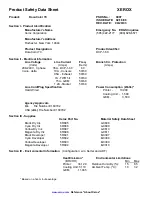
e-STUDIO200L/202L/230/232/280/282 PREVENTIVE MAINTENANCE (PM)
June 2004 © TOSHIBA TEC
4 - 30
4.8.3
Checking and cleaning of drum cleaning blade
1) Handling precautions
Pay attention to the following points as the cleaning blade life is determined by the condition of its
edge:
-
Do not allow hard objects to hit or rub against blade edge.
-
Do not rub the edge with a cloth or soft pad.
-
Do not leave oil (or fingerprints, etc.) on the edge.
-
Do not apply solvents such as paint thinner to the blade.
-
Do not allow paper fibers or dirt to contact the blade edge.
-
Do not place the blade near a heat source.
2) Cleaning procedure
Clean the blade edge with a cloth moistened with water and squeezed lightly.
4.8.4
Checking and cleaning of fuser roller and pressure roller
1) Handling precautions
-
Fuser roller
Do not leave any oil (fingerprints, etc.) on the fuser roller.
Be careful not to allow any hard object to hit or rub against the fuser roller, or it may be damaged,
possibly resulting in poor cleaning.
-
Pressure roller
Do not leave any oil (fingerprints, etc.) on the pressure roller.
2) Checking
-
Check for stain and damage on the fuser and pressure rollers, and clean if necessary.
-
Check the separation guide and fingers and check for chipped tips.
-
Check the cleaning effect of the cleaning roller.
-
Check the thermistors for proper contact with the pressure roller.
-
Check the fused and fixed condition of the toner.
-
Check the gap between the entrance guide and pressure roller.
-
Check the fuser roller for proper rotation.
3) Cleaning procedure
When fuser roller and pressure roller become dirty, they will cause jamming. If this happens, wipe
the surface clean with a piece of soft cloth. For easier cleaning, clean the roller white they are still
warm.
Note:
Note:
Be careful not to rub the fuser roller and pressure roller surface with your nails or hard objects
because it can be easily damaged. Do not use silicone oil on the fuser roller and pressure roller.
4.8.5
Checking and replacing the cleaning roller
1) Handling precautions
Never allow solvents such as paint thinner to touch to the cleaning rollers.
2) Poor cleaning and corrective treatment
Judgment should be made depending on how much toner has been deposited on the pressure roller
surface. When its surface is stained with toner, check the cleaning roller. If toner is heavily adhered
on the cleaning roller, the cleaning roller should be replaced with new ones.
Replace it when a specified number of output pages have been made.
Содержание e-STUDIO200L
Страница 6: ......
Страница 12: ......
Страница 36: ...e STUDIO200L 202L 230 232 280 282 SPECIFICATIONS ACCESSORIES OPTIONS SUPPLIES June 2004 TOSHIBA TEC 1 24 ...
Страница 296: ...e STUDIO200L 202L 230 232 280 282 ERROR CODE AND SELF DIAGNOSTIC MODE June 2004 TOSHIBA TEC 2 260 ...
Страница 400: ...e STUDIO200L 202L 230 232 280 282 ADJUSTMENT June 2004 TOSHIBA TEC 3 104 ...
Страница 554: ...e STUDIO200L 202L 230 232 280 282 TROUBLESHOOTING June 2004 TOSHIBA TEC 5 124 ...
Страница 678: ...e STUDIO200L 202L 230 232 280 282 REMOTE SERVICE June 2004 TOSHIBA TEC 8 24 ...
Страница 700: ...e STUDIO200L 202L 230 232 280 282 DATA CLONING with USB STORAGE DEVICE e STUDIO202L 232 282 June 2004 TOSHIBA TEC 9 22 ...
Страница 702: ...e STUDIO200L 202L 230 232 280 282 WIRE HARNESS CONNECTION DIAGRAMS June 2004 TOSHIBA TEC 10 2 ...
Страница 707: ......
Страница 708: ......
















































